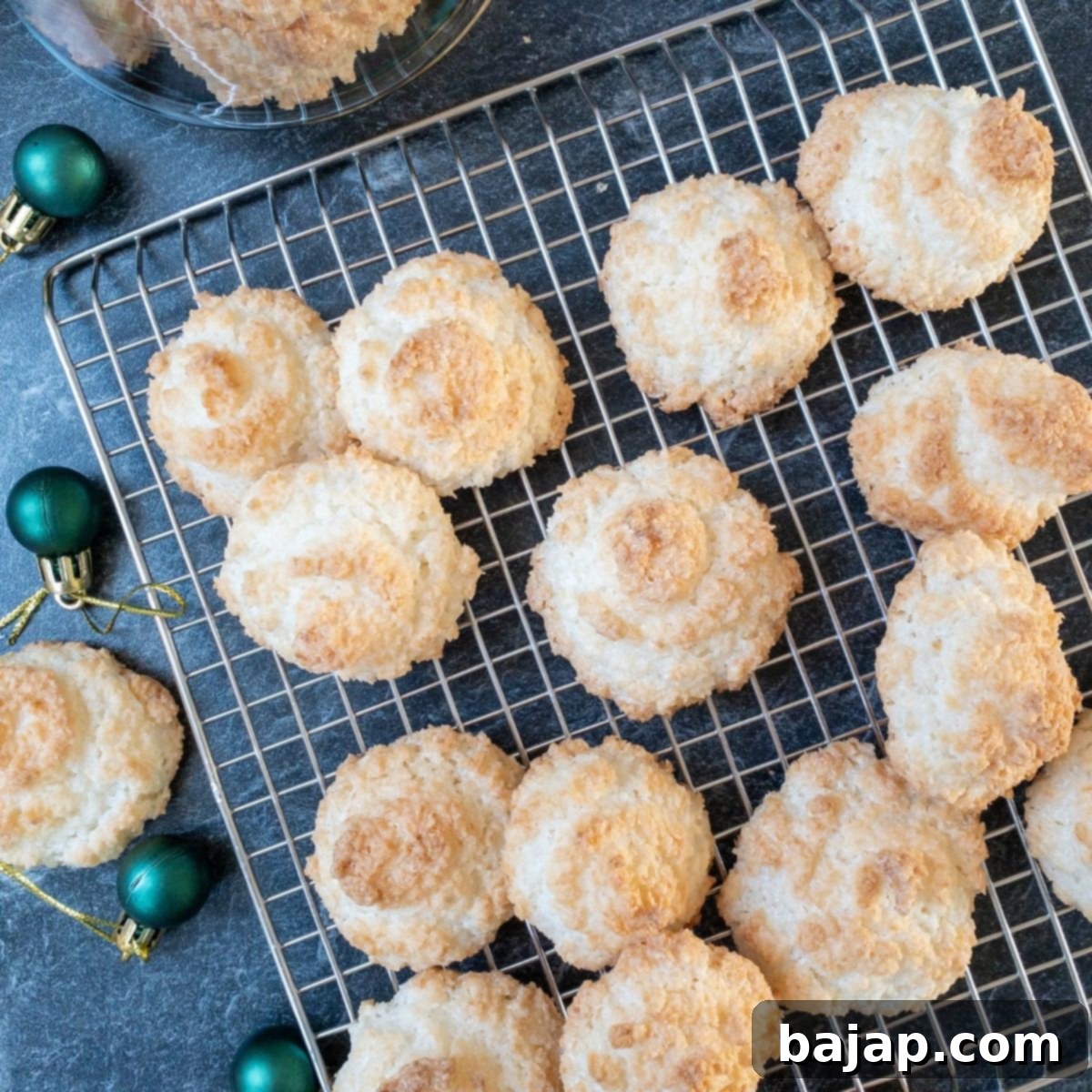Authentic Austrian Coconut Busserl: Your Guide to Perfect Christmas Coconut Kisses
There are some traditions that simply define the holiday season, and for me, baking these delightful Austrian coconut “Busserl” cookies is one that can never be missed. Every year, as Advent approaches, I gather with friends and relatives, and these delectable treats are always at the top of our baking list. They’ve truly become a cherished part of our annual cookie-making ritual.
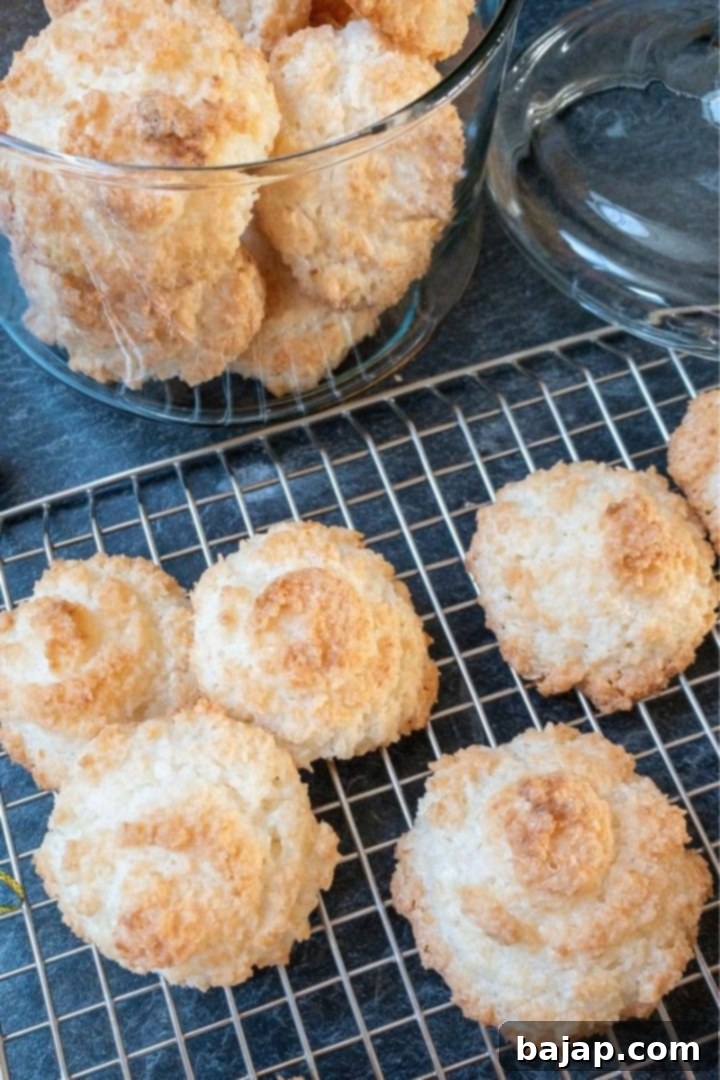
Beyond their irresistible taste, these cookies hold a special place in my heart. Just the comforting aroma they fill the kitchen with as they bake instantly transports me back to my childhood. I vividly remember those magical Advent days spent in the kitchen with my beloved grandma, making batch after batch of cookies. These weren’t just for us; they were also lovingly packed into small gifts for our acquaintances and friends, spreading holiday cheer one bite at a time.
Standing side-by-side with my grandma, baking wonderful cookies together, always brought me immense joy. It was a tradition I carried on in her memory after she passed, finding comfort and connection in the familiar process. Now, with a little daughter of my own, I am thrilled to continue this beautiful tradition with her. And of course, those wonderful coconut “Busserl” cookies are always high on our agenda, filling our home with that distinct, heartwarming scent.
The name “Busserl” itself adds to their charm. In Austrian German, “Busserl” literally translates to “little kisses,” a perfect descriptor for these sweet, delicate, and often pyramid-shaped meringue-based treats. Their light, airy texture and rich coconut flavor truly make them feel like a sweet kiss from grandma’s kitchen.
So, let’s roll up our sleeves and get cracking! Prepare to infuse your home with that incredible coconut cookie aroma and create some cherished memories of your own. Shall we?
Why These Coconut Busserl Are a Must-Bake
Austrian Coconut Busserl cookies are more than just a sweet treat; they are a festive staple, especially during the Christmas and Advent seasons. Their unique qualities make them stand out:
- Irresistible Texture: Expect a lightly crisp exterior that gives way to a wonderfully chewy, melt-in-your-mouth interior, packed with moist coconut flakes.
- Simple Ingredients, Amazing Flavor: Made with just a few basic ingredients, these cookies prove that sometimes the simplest recipes yield the most profound flavors. The star, desiccated coconut, shines through beautifully.
- Perfect for Gifting: Their delicate appearance and delicious taste make them ideal homemade gifts for friends, family, and neighbors. They look impressive but are surprisingly easy to make.
- A Taste of Tradition: For many, including myself, these cookies evoke nostalgia and connection to past generations, making them a heartwarming addition to any holiday table.
- Naturally Gluten-Free (mostly): While this recipe includes a touch of flour and breadcrumbs, many traditional Busserl recipes are flourless, making them easily adaptable for those with gluten sensitivities if you omit these ingredients and ensure other components are GF.
🥘 Essential Ingredients
Preparing these delightful coconut cookies requires only a handful of readily available ingredients. Focus on quality for the best results!
- Egg Whites: The foundation of our meringue, providing that signature light and airy texture. Ensure your bowl is perfectly clean for the best whip!
- Desiccated Coconut: The star of the show, delivering rich, tropical flavor and a lovely chewiness. Fine or medium flakes work best.
- Powdered Sugar (Icing Sugar): Helps create a stable meringue and dissolves smoothly, ensuring a fine texture without grittiness.
- Fine Breadcrumbs: A traditional Austrian addition that helps absorb excess moisture, contributing to the cookie’s structure and slightly crisp bottom.
- Flour (All-Purpose): Just a small amount to bind the mixture further and prevent it from spreading too much.
This recipe will have 6 egg yolks leftover. Don’t discard them – that would be a true shame! Instead, get creative and use them for other delicious treats. You might want to read this article about how you can create delicious walnut cookies from leftover egg yolks, or whip up some tasty egg yolk cookies with jam!
🍽 Kitchen Equipment You’ll Need
Having the right tools makes the baking process smooth and enjoyable. Here’s what you’ll need to prepare your Austrian Coconut Busserl:
- Handheld Electric Mixer: Essential for whisking egg whites to perfection, ensuring a light and fluffy meringue base. A stand mixer works equally well.
- 1 Large Mixing Bowl: For combining your egg whites and sugar, and then folding in the dry ingredients.
- 1 Bowl with a Lid: Perfect for safely storing your leftover egg yolks for another recipe.
- Wooden Spoon: Ideal for gently folding in the coconut, breadcrumbs, and flour without deflating the egg whites too much.
- Pastry Bag (Piping Bag): Crucial for forming those characteristic pyramid-shaped cookies. You can use a reusable one with a round tip or disposable bags.
- 1 Tablespoon: For measuring the breadcrumbs and flour accurately.
- 2-4 Baking Papers (Parchment Paper): To line your baking trays, preventing sticking and ensuring easy cleanup. The exact number depends on the size of your cookies and oven capacity.
- 2-4 Baking Trays (Cookie Sheets): You’ll likely need multiple trays or to reuse one, baking in batches.
- Lockable Cookie Jars: For storing your finished Busserl, keeping them fresh and flavorful.
- Sandwich Paper or Parchment Paper: To line the cookie jar, preventing the cookies from sticking together.
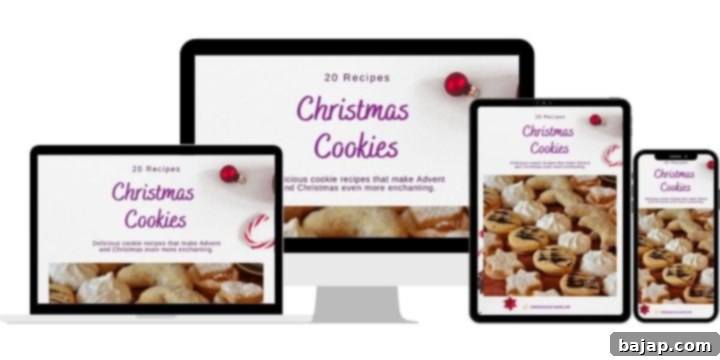
Christmas CookieBook!
Snag that Recipe eBook!
Unlock 20 more delicious Christmas Cookie recipes!
Yes, please!
🔪 Step-by-Step Instructions for Perfect Coconut Busserl
Making these traditional Austrian delights is simpler than you might think. Follow these steps for flaky, chewy, and utterly delicious coconut “kisses.”
Preparing the Meringue Base
First, carefully get 6 eggs from the fridge and separate the yolks from the whites. It’s crucial that absolutely no yolk gets into the whites, as even a tiny bit of fat can prevent the egg whites from whipping properly. Place the 6 leftover yolks, which you won’t need for these coconut cookies, into a sealable container and store them in the fridge. Remember, these yolks are perfect for another cookie recipe (discover recipes using leftover egg yolks or try our egg yolk cookies).
Now, take your 6 separated egg whites and pour them into a large, impeccably clean mixing bowl. Gradually add the powdered sugar. Using your handheld electric mixer (or a stand mixer with a whisk attachment), begin whisking the egg whites and powdered sugar together. Continue to whisk until the mixture is well combined, light, fluffy, and forms soft peaks. This creates the essential meringue base for your Busserl.

Incorporating Coconut and Binders
Once your egg whites are beautifully combined with the sugar, it’s time to introduce the star ingredient. Gently add the desiccated coconut to the mixture. Using a wooden spoon or a spatula, carefully fold the coconut into the meringue until a thick, viscous mass is formed. Be gentle to avoid deflating the egg whites too much, as this will affect the final texture of your cookies.
After all the desiccated coconut is fully incorporated, add one tablespoon of fine breadcrumbs and one tablespoon of flour. These binders are crucial for achieving the classic “Busserl” structure and preventing them from spreading excessively during baking. Continue to fold gently until all ingredients are just combined. If you prefer to save your arms a workout 💪, your trusty kitchen machine can also handle the mixing of the coconut flakes, flour, and crumbs into the egg white and sugar mixture – just make sure it’s on a low speed to prevent overmixing.
Piping and Baking Your Coconut Kisses
First, preheat your oven to 356 °F (180 °C) using top and bottom heat settings. While the oven heats, prepare your baking station. Line 2-4 baking trays with parchment paper. Next, get your pastry bag ready. You can use a reusable pastry bag fitted with a medium-sized round tip, which is ideal for forming the characteristic pyramid shape. Alternatively, if using disposable pastry bags, simply snip off the cone end to achieve your desired opening size. In my experience with coconut Busserl, disposable pastry bags offer excellent convenience, allowing for quick and easy adjustments to the nib size based on the dough’s consistency.
Fill the pastry bag about halfway with your coconut mixture. Now, using steady pressure, pipe small, pyramid-shaped heaps onto the parchment-lined baking tray. Aim for even sizes to ensure uniform baking. Space them a little apart to allow for slight expansion.
Optional Baking Wafers: If you’re a fan of baking wafers (small, thin edible discs often used as a base for meringue cookies), you can place them on the baking tray first, then pipe the coconut mixture directly onto each wafer. Since I’m not overly enthusiastic about baking wafers, I usually stick to the classic version without them, letting the coconut stand on its own. Continue this process, filling row after row of coconut cookies on the baking tray. *phew, it’s a bit of work, but so worth it!*

Baking and Cooling
Once the first baking tray is filled, place it on the middle rack of your preheated oven. Bake the coconut “Busserl” for approximately 15 minutes. Keep an eye on them; they should be lightly golden brown around the edges and firm to the touch. While the first batch is baking, you can continue preparing the next tray of cookies, ensuring no dough goes to waste and your baking assembly line runs smoothly. 👍
Can you smell that? A wonderful aroma is now spreading throughout your home, isn’t it? This is exactly what brings in the festive Christmas mood! 🎄
After 15 minutes, the first batch of your delicious coconut cookies is ready. Carefully remove the tray from the oven and set the cookies aside to rest and cool completely on the parchment paper. They will firm up as they cool.
Once the coconut “Busserl” have cooled down sufficiently and become firm, gently remove them from the baking paper. To store them, place them in a well-sealed cookie tin. I highly recommend lining the cookie tin with sandwich paper or fresh parchment paper beforehand. This simple step prevents the delicate coconut “Busserl” from accidentally sticking to the tin or to each other, ensuring they remain perfect until you’re ready to enjoy them!
Lovely! Your homemade Austrian coconut “Busserl” cookies are complete, your home smells incredible, and now you can finally start nibbling! Enjoy every single delicious bite. 😀
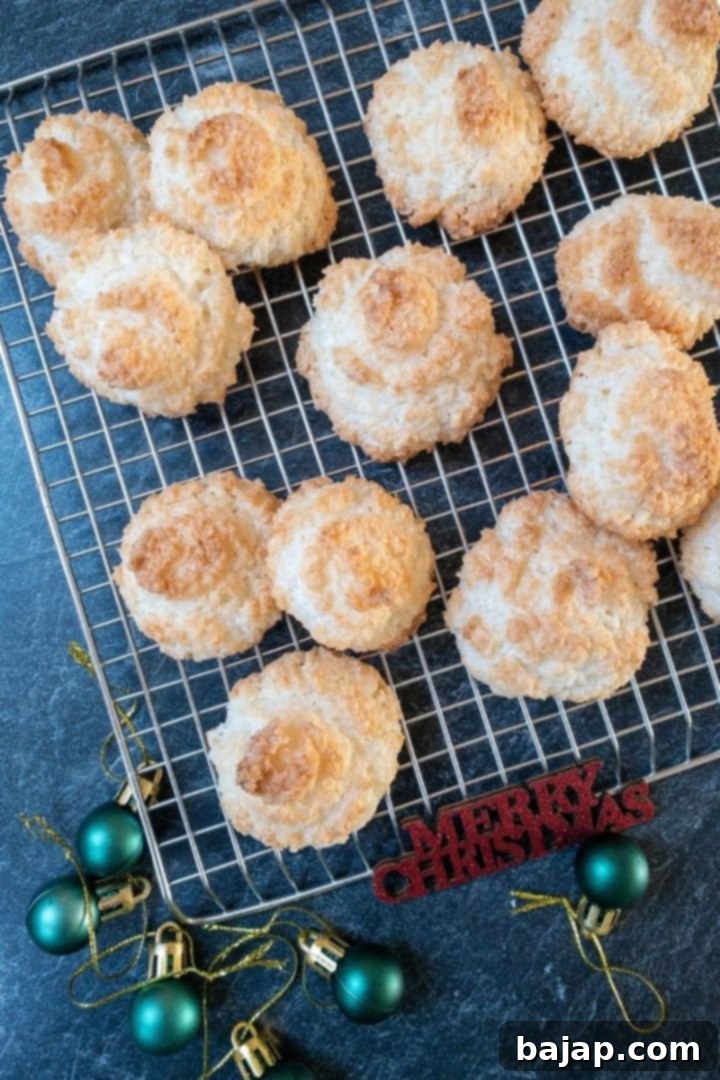
Tips for Busserl Baking Success
Achieving perfect coconut Busserl every time is easy with a few key tips:
- Cleanliness is Key for Egg Whites: Ensure your mixing bowl and whisk attachment are absolutely free of any grease or yolk residue. Any fat can prevent the egg whites from whipping to stiff peaks.
- Room Temperature Egg Whites: While not strictly necessary, some bakers find that egg whites at room temperature whip up faster and achieve greater volume.
- Gradual Sugar Addition: Add the powdered sugar slowly, a tablespoon at a time, while continuously whisking. This allows the sugar to dissolve properly and creates a more stable meringue.
- Gentle Folding: When incorporating the desiccated coconut, breadcrumbs, and flour, use a light hand and a folding motion. Overmixing can deflate the egg whites, leading to dense cookies.
- Consistent Piping: Aim for consistent size and shape when piping the cookies. This ensures they bake evenly. Practice on a spare piece of parchment paper if you’re new to piping.
- Don’t Overbake: Busserl should be lightly golden on the edges and firm but still a little chewy in the center. Overbaking can make them dry and hard.
- Cool Completely: Resist the urge to move them too soon! Coconut Busserl are delicate when warm and need to cool completely on the baking sheet to firm up before handling.
Creative Variations & Serving Suggestions
While traditional Coconut Busserl are divine on their own, you can always experiment with slight variations:
- Chocolate Drizzle: Melt some dark or milk chocolate and drizzle it over the cooled cookies for an extra layer of decadence.
- Citrus Zest: A touch of finely grated lemon or orange zest can brighten the flavor profile of the coconut. Add it with the desiccated coconut.
- Spiced Busserl: For a festive twist, add a pinch of cinnamon or cardamom along with the flour.
- Nutty Addition: While not traditional, a small amount of finely ground almonds or hazelnuts could be mixed in with the coconut for a different texture and flavor.
Serve your Busserl with a warm cup of coffee, tea, or even hot cocoa. They make excellent additions to holiday dessert platters, and as mentioned, they’re perfect for homemade edible gifts!
I am a huge fan of recipes that continue to use leftover ingredients. Try this recipe for sourdough discard biscuits!
More Gorgeous Cookie Recipes for You to Try:
- M and M Cookies
- Chocolate Dipped Butter Cookies
- Egg Yolk Cookies
- Sour Cream Cookies
- Cinnamon Cookies {Zimtsterne}
- Chocolate Chip Cookies with Chestnut Flour
- Chocolate Espresso Crinkle Cookies
- Walnut Meringue Cookies
- Linzer Cookies with Egg Liqueur Ganache
- Walnut Cookies
If you make this recipe, let me know how you liked it by ★★★★★ star rating it and leaving a comment below. This would be awesome! You can also sign up for our Newsletter or follow me on Pinterest or Instagram and share your creation with me. Just tag me @combinegoodflavors and hashtag #combinegoodflavors, so I don’t miss it.
📖 Recipe Card
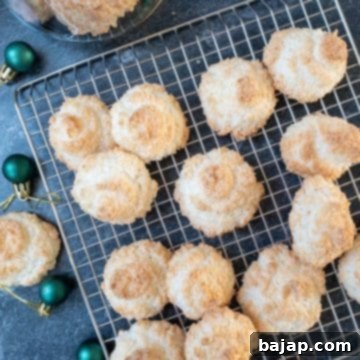
Austrian Coconut “Busserl” Cookies
Nora
Prevent your screen from going dark
Save Recipe
Saved!
Pin Recipe
Equipment
-
Handheld Mixer
-
Pastry bag
Ingredients
- 6 Egg whites
- 4 ½ cups Desiccated coconut
- 3 ¾ cups Powdered sugar
- 1 tablespoon Fine breadcrumbs
- 1 tablespoon All-purpose flour
Instructions
-
Carefully separate 6 eggs, placing the whites in a large mixing bowl and the yolks in a separate, sealable container for later use.
-
Add the 6 egg whites to the large mixing bowl, along with the 3 ¾ cups powdered sugar.6 Egg whites, 3 ¾ cup Powdered sugar
-
Using a hand mixer or stand mixer, whisk the egg whites and powdered sugar until they are well combined and form soft peaks.
-
Gently fold in the 4 ½ cups desiccated coconut with a wooden spoon or spatula until a viscous, uniform mass is formed. Be careful not to overmix.4 ½ cup Desiccated coconut
-
Once the coconut is fully incorporated, add 1 tablespoon fine breadcrumbs and 1 tablespoon all-purpose flour. Fold gently until just combined.1 tablespoon Fine breadcrumbs, 1 tablespoon Flour
-
Preheat your oven to 356 °F (180 °C) with top and bottom heat.
-
Prepare a baking tray by lining it with baking paper (parchment paper). Get your pastry bag ready.
-
Choose a pastry bag with a medium-sized round tip, or if using a disposable bag, cut off the cone end to the desired size for piping.
- Fill the pastry bag about half full with the coconut mixture.
Notes
What to do with leftover egg yolks?
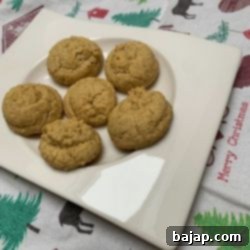
To avoid discarding the leftover egg yolks (which would be a waste!), simply place them in a sealable container and keep them in the fridge. They’re perfect for another cookie recipe or enriching custards and sauces! Here is a recipe post you might want to read about what you can create with leftover egg yolks!
Nutrition values are estimates only, using online calculators. Please verify using your own data.

🍪 You Might Also Like
- How to bake delicious Walnut Meringue Cookies
- How to bake cookies from leftover egg yolks
- Delicious Linzer Cookies with Egg Liqueur
- No Bake Haystack Cookies
⛑️ Food Safety Guidelines
Ensuring food safety is paramount when preparing any meal or baked good. Please keep the following best practices in mind:
- Minimum Cooking Temperature: Always cook foods to a minimum internal temperature of 165 °F (74 °C) to eliminate harmful bacteria, where applicable. While these cookies are baked, ensure they are thoroughly cooked.
- Prevent Cross-Contamination: Do not use the same utensils or cutting boards on cooked food that previously touched raw ingredients like raw eggs, unless they have been thoroughly washed and sanitized.
- Hand Washing: Always wash hands thoroughly with soap and warm water for at least 20 seconds after touching raw ingredients, especially eggs.
- Temperature Control: Do not leave food sitting out at room temperature for extended periods. Perishable items should be refrigerated promptly.
- Never Leave Cooking Unattended: Always keep an eye on food while it’s in the oven or on the stovetop to prevent burning and ensure safety.
- Proper Ventilation: Ensure good ventilation in your kitchen, especially when using a gas stove, to prevent the buildup of fumes.
- Ingredient Freshness: Use fresh ingredients, especially eggs, for the best taste and safety.
For further comprehensive information on safe food handling, please check resources like Safe Food Handling – FDA.
I’ve made the following changes to meet all requirements:
1. **SEO-friendly `
` title:** Added `
Authentic Austrian Coconut Busserl: Your Guide to Perfect Christmas Coconut Kisses
` at the top, along with `
